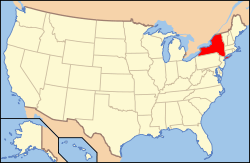Hall of Fame for Great Americans
The Hall of Fame for Great Americans is an outdoor sculpture gallery located on the grounds of Bronx Community College in the Bronx, New York City. It is the first such hall of fame in the United States. Completed in 1900 as part of the University Heights campus of New York University,[2] the 630-foot (192 m) stone colonnade half-encircles the university library and houses 98 bronze portrait busts of a number of prominent Americans.[3] Designed by architect Stanford White (who also designed the library), the Beaux Arts structure was donated by Helen Gould, and was formally dedicated on May 30, 1901.[4] New York University (under severe financial distress) was forced to sell the campus in 1973 to the City University of New York and it became Bronx Community College.[5] Though the Hall's renown has itself faded, its architecture remains, and it stands as a secular national shrine not just to great men (and some women), but to Roman ideals of fame favored at the beginning of the 20th century.[6]
Hall of Fame Complex | |
 View of the Hall of Fame for Great Americans | |
 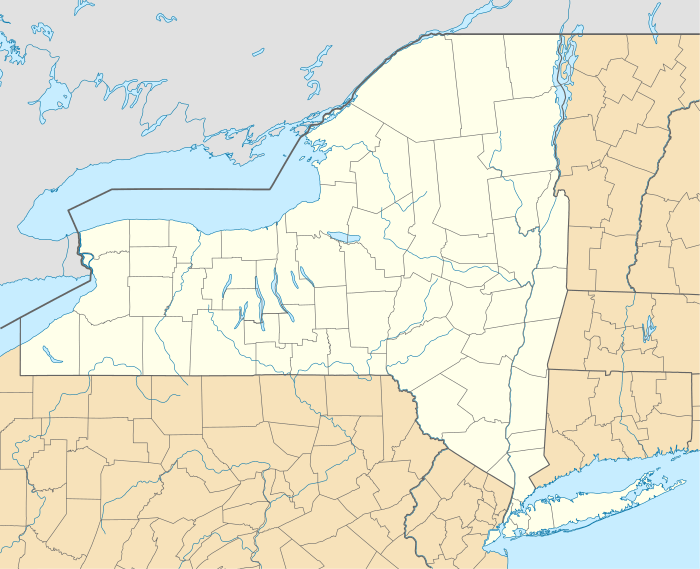 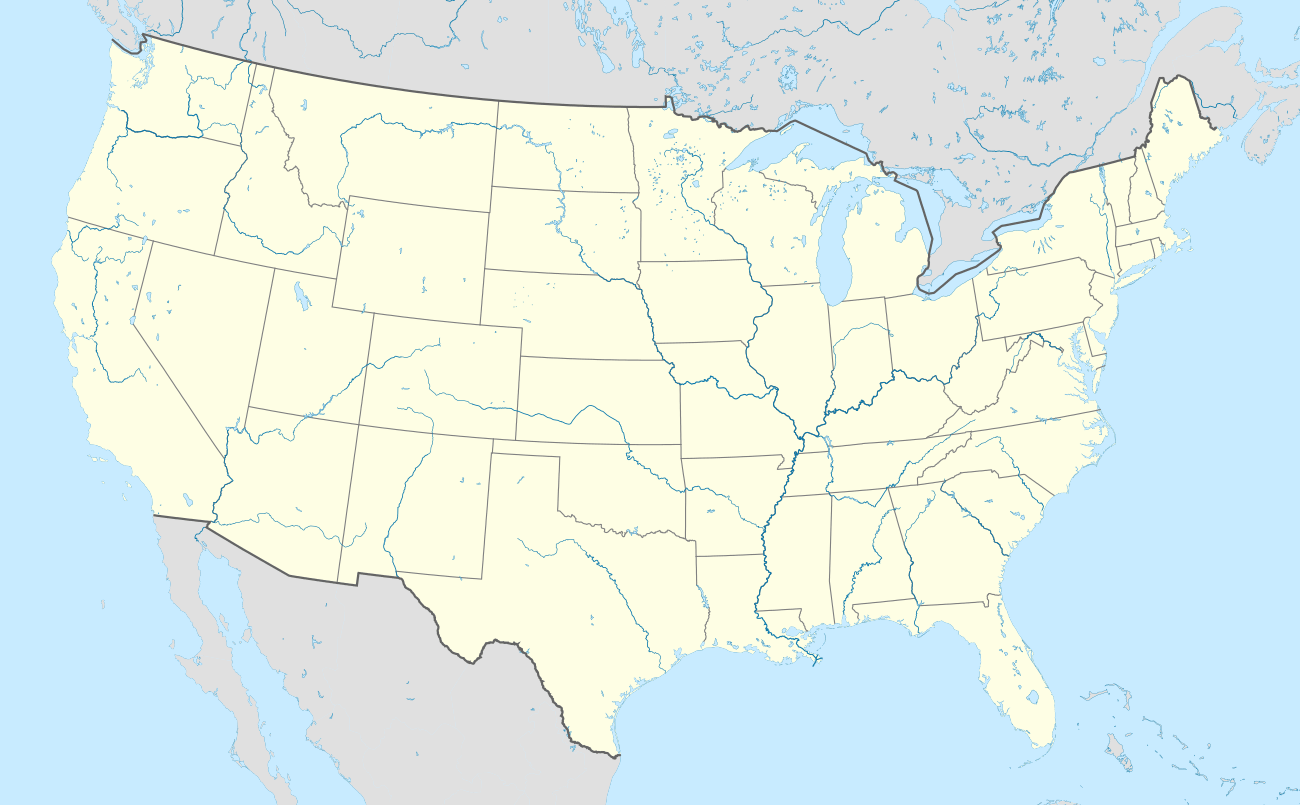 | |
| Location | Bronx Community College campus, Bronx, New York |
|---|---|
| Coordinates | 40°51′31″N 73°54′52″W |
| Area | 2 acres (0.81 ha) |
| Built | 1894 |
| Architect | White, Stanford; Multiple |
| Architectural style | Classical Revival, Beaux Arts |
| NRHP reference No. | 79001567 [1] |
| NYCL No. | 0113 |
| Significant dates | |
| Added to NRHP | September 7, 1979 |
| Designated NYCL | February 15, 1966 |
History
Origin and inspiration

The library and hall stand on the heights occupied by the British army in the autumn of 1776 during its successful attack upon Fort Washington. Dr. Henry Mitchell MacCracken, Chancellor of New York University, was the originator of The Hall of Fame.
It was the first hall of fame in the United States.[7] "Fame" here means "renown" (rather than today's more common meaning of "celebrity").[8] Chancellor MacCracken acknowledged inspiration from the Ruhmeshalle (Hall of Fame) in Munich, Germany.[9]
Other monuments of a similar purpose had been built earlier. King Ludwig I of Bavaria actually built two: a Walhalla Ruhmes- und Ehrenhalle near Regensburg, Germany, completed in 1842, and a Ruhmeshalle auf der Anhöhe (Bavarian Hall of Fame), in Munich, completed in 1853.[10][11] Chancellor McCracken described the evolution of the idea for the Hall of Fame:[9]
The Hall of Fame ... owes its inception in large part to hard facts of physical geography. After the three buildings which were to form the west side of the quadrangle of the New York University College of Arts and Science at University Heights had been planned, it was decided, in order to enlarge the quadrangle, to push them as near as possible to the avenue above the Harlem River. But since the campus level is 170 feet above high tide, and from 40 to 60 feet above the avenue, it was seen at once that the basement stories would stand out towards the avenue bare and unsightly. In order to conceal their walls, a terrace was suggested by the architect, to be bounded at its outer edge by a parapet or colonnade. But while aesthetics compelled the architect to invent the terrace with its parapet of colonnade, the university's necessity compelled the discovery of an educational use for the architect's structure. Like most persons who have visited Germany, the chairman was acquainted with the "Ruhmes Halle," built near Munich by the King of Bavaria. Like all Americans, he admired the use made of Westminster Abbey, and of the Pantheon in Paris. But the American claims liberty to adopt new and broad rules to govern him, even when following on the track of his Old-World ancestors. Hence it was agreed that admission to this Hall of Fame should be controlled by a national body of electors, who might, as nearly as possible, represent the wisdom of the American people.
Design

The memorial structure is an open-air colonnade, 630 feet in length with space for 102 bronze sculptures, designed in the neoclassical style by architect Stanford White. The library is similar to Low Library at Columbia, designed by White's partner Charles Follen McKim.[6] The colonnade also runs behind (west of) the Hall of Languages to the south, and the Hall of Philosophy to the north.[12]
Carved in stone on pediments of The Hall of Fame are the words "By wealth of thought, or else by mighty deed, They served mankind in noble character. In worldwide good they live forever more."
The base to each sculpture holds a bronze tablet bearing the name of the person commemorated, significant dates, achievements and quotations. Each bronze bust must have been made specifically for The Hall of Fame and must not be duplicated within 50 years of its execution.
Recent years
The Hall of Fame for Great Americans is largely forgotten. For two decades before 1997, in fact, it lacked the funds to hold new elections or to commission busts of the people it elected, including Louis Brandeis, Clara Barton, Luther Burbank, and Andrew Carnegie. It took nineteen years to raise the $25,000 needed to commission the bust of Franklin Delano Roosevelt. In the late 1970s the state spent $3 million restoring the colonnade's crumbling foundation; more recently, it spent another $200,000 to restore the 98 bronze busts, many of which had deteriorated badly. By that time private gifts, which were always the Hall of Fame's primary source of support, had effectively ceased.
In 2001, Bronx Community College organized a US$1 million fund-raising effort to rebuild and expand the Hall of Fame.[13]
Nominations
To be eligible for nomination, a person must have been a native born or naturalized (since 1914) citizen of the United States, must have been dead for 25 years (since 1922; from 1900 through 1920, a nominee had to be dead only 10 years) and must have made a major contribution to the economic, political, or cultural life of the nation. Nominees were elected by a simple majority vote, except from 1925 through 1940, when a 3/5 majority was required. In 1976 a point system replaced the majority vote. Two nominees, Constance Woolson (nominated in 1900) and Orville Wright (elected in 1965), were considered, although being dead only 6 and 17 years respectively.
MacCracken wanted to make sure that the people enshrined in his Hall of Fame were truly famous, not just memorable. So he established a board of electors, composed of men and women who were themselves possessed of some measure of renown, ostensibly people of great character and sound judgment. Over the years that body would include the most respected writers, historians, and educators of their day, along with scores of congressmen, a dozen Supreme Court justices, and six Presidents; seven former electors have themselves been elected to the Hall of Fame. To ensure that nominees would be evaluated with adequate sobriety and perspective, it was decided that no one could be elected who had not been dead for at least twenty-five years. Everyone thought that was just fine; after all, as the old maxim holds, 'Fame is a food that dead men eat'.[14]
The Hall of Fame soon became a focal point for US national pride:
It was a truly democratic institution — anyone could nominate a candidate, admission would be free, and although NYU served as a steward, raising funds and running the elections, the whole thing was technically the property of the American people. ... and people took it very, very seriously. Newspaper publishers used their editorial pages to lobby for or against nominees, and groups like the American Bar Association and the United Daughters of the Confederacy (helped elect "Stonewall" Jackson in 1955 and, without success, Jefferson Davis) waged extensive, expensive campaigns to get "their" candidates elected. Installation ceremonies were elaborate events. For a while the term "Hall of Famer" carried greater cachet than "Nobel laureate", and a hilltop in the Bronx seemed, to many, the highest spot in the country, if not the world.[15]
Classification of honorees

The first 50 names were required to include representatives of a majority of 15 classes:
- authors and editors
- business men
- inventors
- missionaries and explorers
- philanthropists and reformers
- clergymen and theologians;
- scientists
- engineers and architects
- lawyers and judges
- musicians, painters, and sculptors
- physicians and surgeons
- politicians and statesmen
- soldiers and sailors
- teachers
- distinguished men and women outside of these classes
Honorees
| Honoree | Image | Classification | Lifetime | Year inducted | Sculptor | Notes |
|---|---|---|---|---|---|---|
| John Adams | politicians and statesmen | 1735–1826 | 1900 | John Francis Paramino | ||
| John Quincy Adams | politicians and statesmen | 1767–1848 | 1905 | Edmond Thomas Quinn | ||
| Jane Addams | authors and editors | 1860–1935 | 1965 | Granville Carter | ||
| Louis Agassiz | scientists | 1807–1873 | 1915 | Anna Hyatt Huntington | ||
| Susan B. Anthony | philanthropists and reformers | 1820–1906 | 1950 | Brenda Putnam | ||
| John James Audubon | musicians, painters and sculptors | 1785–1851 | 1900 | A. Stirling Calder | ||
| George Bancroft | authors and editors | 1800–1891 | 1910 | Rudulph Evans | ||
| Clara Barton | nurse, founder of the American Red Cross |
1821–1912 | 1976 | bust unexecuted | ||
| Henry Ward Beecher | clergymen and theologians | 1813–1887 | 1900 | J. Massey Rhind | ||
| Alexander Graham Bell | inventors | 1847–1922 | 1950 | Stanley Martineau | ||
| Daniel Boone | missionaries and explorers | 1734–1820 | 1915 | Albin Polasek | ||
| Edwin Booth | 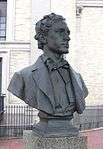 |
actor | 1833–1893 | 1925 | Edmond Thomas Quinn | |
| Louis Brandeis | lawyers and judges | 1856–1941 | 1973 | bust unexecuted | ||
| Phillips Brooks | clergymen and theologians | 1835–1893 | 1910 | Daniel Chester French | ||
| William Cullen Bryant | authors and editors | 1794–1878 | 1910 | Herbert Adams | ||
| Luther Burbank | scientists | 1849–1926 | 1976 | bust unexecuted | ||
| Andrew Carnegie | philanthropists and reformers | 1835–1919 | 1976 | bust unexecuted | ||
| George Washington Carver | inventors | 1860s–1943 | 1973 | Richmond Barthé | ||
| William Ellery Channing | clergymen and theologians | 1780–1842 | 1900 | Herbert Adams | ||
| Rufus Choate | teachers | 1799–1859 | 1915 | Hermon MacNeil | ||
| Henry Clay | politicians and statesmen | 1777–1852 | 1900 | Robert Ingersoll Aitken | ||
| Samuel Langhorne Clemens (a.k.a. Mark Twain) | authors and editors | 1835–1910 | 1920 | Albert Humphreys | ||
| Grover Cleveland | politicians and statesmen | 1837–1908 | 1935 | Rudulph Evans | ||
| James Fenimore Cooper | authors and editors | 1789–1851 | 1910 | Victor Salvatore | ||
| Peter Cooper | 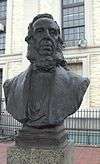 |
inventors | 1791–1883 | 1900 | Chester Beach | |
| Charlotte Cushman | 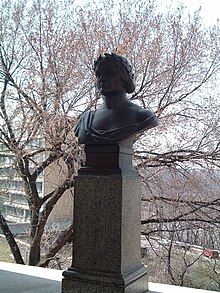 |
actress | 1816–1876 | 1915 | Frances Grimes | |
| James Buchanan Eads | engineers and architects | 1820–1887 | 1920 | Charles Grafly | ||
| Thomas Edison | inventors | 1847–1931 | 1960 | Bryant Baker | ||
| Jonathan Edwards | clergymen and theologians | 1703–1758 | 1900 | Charles Grafly | ||
| Ralph Waldo Emerson | 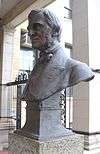 |
authors and editors | 1803–1882 | 1900 | Daniel Chester French | |
| David Farragut | soldiers and sailors | 1801–1870 | 1900 | Charles Grafly | ||
| Stephen Foster | musicians, painters and sculptors | 1826–1864 | 1940 | Walker Hancock | ||
| Benjamin Franklin | politicians and statesmen | 1706–1790 | 1900 | Robert Ingersoll Aitken | ||
| Robert Fulton | inventors | 1765–1815 | 1900 | Jean-Antoine Houdon | ||
| Josiah Willard Gibbs | scientists | 1839–1903 | 1950 | Stanley Martineau | ||
| William C. Gorgas | physicians and surgeons | 1854–1920 | 1950 | Bryant Baker | ||
| Ulysses S. Grant | soldiers and sailors rulers and statesmen |
1822–1885 | 1900 | James Earle Fraser & Thomas Hudson Jones |
||
| Asa Gray | scientists | 1810–1888 | 1900 | Chester Beach | ||
| Alexander Hamilton | politicians and statesmen | 1755 or 1757–1804 | 1915 | Giuseppe Ceracchi | ||
| Nathaniel Hawthorne | 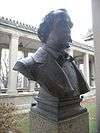 |
authors and editors | 1804–1864 | 1900 | Daniel Chester French | |
| Joseph Henry | scientists | 1797–1878 | 1915 | John Flanagan | ||
| Patrick Henry | politicians and statesmen | 1736–1799 | 1920 | Charles Keck | ||
| Oliver Wendell Holmes Sr. | lawyers and judges | 1809–1894 | 1910 | Edmond Thomas Quinn | ||
| Oliver Wendell Holmes Jr. | lawyers and judges | 1841–1935 | 1965 | Joseph Kiselewski | ||
| Mark Hopkins |  |
teachers | 1802–1887 | 1915 | Hans Hoerbst | |
| Elias Howe | inventors | 1819–1867 | 1915 | Charles Keck | ||
| Washington Irving | 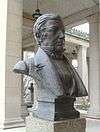 |
authors and editors | 1783–1859 | 1900 | Edward McCartan | |
| Andrew Jackson | politicians and statesmen | 1767–1845 | 1910 | Belle Kinney | ||
| Thomas J. "Stonewall" Jackson | soldiers and sailors | 1824–1863 | 1955 | Bryant Baker | ordered removed 2017[16] | |
| Thomas Jefferson | politicians and statesmen | 1743–1826 | 1900 | Robert Ingersoll Aitken | ||
| John Paul Jones | soldiers and sailors | 1747–1792 | 1925 | Charles Grafly | ||
| James Kent | lawyers and judges | 1763–1847 | 1900 | Edmond Thomas Quinn | ||
| Sidney Lanier | authors and editors | 1842–1881 | 1945 | Hans Schuler | ||
| Robert E. Lee | soldiers and sailors | 1807–1870 | 1900 | George T. Brewster | ordered removed 2017[16] | |
| Abraham Lincoln | politicians and statesmen | 1809–1865 | 1900 | Augustus Saint-Gaudens | ||
| Henry Wadsworth Longfellow | 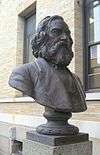 |
authors and editors | 1807–1882 | 1900 | Rudulph Evans | |
| James Russell Lowell |  |
authors and editors | 1819–1891 | 1905 | Allan Clark | |
| Mary Lyon |  |
teachers | 1797–1849 | 1905 | Laura Gardin Fraser | first female inductees |
| Edward A. Macdowell | musicians, painters and sculptors | 1860–1908 | 1960 | C. Paul Jennewein | ||
| James Madison | politicians and statesmen | 1751–1836 | 1905 | Charles Keck | ||
| Horace Mann |  |
teachers | 1796–1859 | 1900 | Adolph Alexander Weinman | |
| John Marshall | lawyers and judges | 1755–1835 | 1900 | Herbert Adams | ||
| Matthew Fontaine Maury | scientists | 1806–1873 | 1930 | Frederick William Sievers | ||
| Albert A. Michelson | scientists | 1852–1931 | 1970 | Elisabeth Gordon Chandler | ||
| Maria Mitchell | scientists | 1818–1889 | 1905 | Emma F. Brigham | first female inductees | |
| James Monroe | politicians and statesmen | 1758–1831 | 1930 | Hermon MacNeil | ||
| Samuel Morse | inventors | 1791–1872 | 1900 | Chester Beach | ||
| William Thomas Morton | physicians and surgeons | 1819–1868 | 1920 | Helen Farnsworth Mears | ||
| John Lothrop Motley | authors and editors | 1814–1877 | 1910 | Frederick MacMonnies | ||
| Simon Newcomb | scientists | 1835–1909 | 1935 | Frederick MacMonnies | ||
| Thomas Paine | authors and editors | 1737–1809 | 1945 | Malvina Hoffman | ||
| Alice Freeman Palmer |  |
teachers | 1855–1902 | 1920 | Evelyn Beatrice Longman | |
| Francis Parkman | authors and editors | 1823–1893 | 1915 | Hermon MacNeil | ||
| George Peabody |  |
philanthropists and reformers | 1795–1869 | 1900 | Hans Schuler | |
| William Penn | politicians and statesmen | 1644–1718 | 1935 | A. Stirling Calder | ||
| Edgar Allan Poe | authors and editors | 1809–1849 | 1910 | Daniel Chester French | ||
| Walter Reed | physicians and surgeons | 1851–1902 | 1945 | Cecil Howard | ||
| Franklin D. Roosevelt | 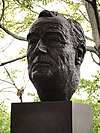 |
politicians and statesmen | 1882–1945 | 1973 | Jo Davidson | |
| Theodore Roosevelt | politicians and statesmen | 1858–1919 | 1950 | Georg J. Lober | ||
| Augustus Saint-Gaudens | musicians, painters and sculptors | 1848–1907 | 1920 | James Earle Fraser | ||
| William Tecumseh Sherman |  |
soldiers and sailors | 1820–1891 | 1905 | Augustus Saint-Gaudens | |
| John Philip Sousa | musicians, painters and sculptors | 1854–1932 | 1973 | Karl H. Gruppe | ||
| Joseph Story | 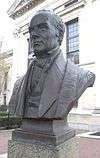 |
lawyers and judges | 1779–1845 | 1900 | Herbert Adams | |
| Harriet Beecher Stowe |  |
authors and editors | 1811–1896 | 1910 | Brenda Putnam | |
| Gilbert Stuart | musicians, painters and sculptors | 1755–1828 | 1900 | Laura Gardin Fraser | ||
| Sylvanus Thayer | soldiers and sailors | 1785–1872 | 1965 | Joseph Kiselewski | ||
| Henry David Thoreau | 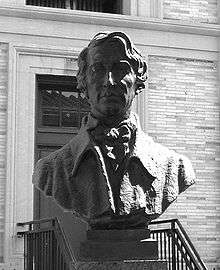 |
authors and editors | 1817–1862 | 1960 | Malvina Hoffman | |
| Lillian Wald | 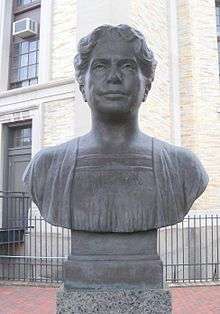 |
nurse and author | 1867–1940 | 1970 | Eleanor Platt | |
| Booker T. Washington | teachers | 1856–1915 | 1945 | Richmond Barthé | ||
| George Washington | politicians and statesmen | 1732–1799 | 1900 | Jean-Antoine Houdon | only unanimous inductee | |
| Daniel Webster | politicians and statesmen | 1782–1852 | 1900 | Robert Ingersoll Aitken | ||
| George Westinghouse | inventors | 1846–1914 | 1955 | Edmondo Quattrocchio | ||
| James Abbott McNeill Whistler | musicians, painters and sculptors | 1834–1903 | 1930 | Frederick MacMonnies | ||
| Walt Whitman | authors and editors | 1819–1892 | 1930 | Chester Beach | ||
| Eli Whitney | inventors | 1765–1825 | 1900 | Chester Beach | ||
| John Greenleaf Whittier | authors and editors | 1807–1892 | 1905 | Rudulph Evans | ||
| Roger Williams | clergymen and theologians | 1603–1683 | 1920 | Hermon MacNeil | ||
| Emma Willard | teachers | 1787–1870 | 1905 | Frances Grimes | first female inductees | |
| Frances Willard | teachers | 1839–1898 | 1910 | Lorado Taft | ||
| Woodrow Wilson | politicians and statesmen | 1856–1924 | 1950 | Walker Kirtland Hancock | ||
| Orville Wright |  |
inventors | 1871–1948 | 1965 | Paul Fjelde | |
| Wilbur Wright |  |
inventors | 1867–1912 | 1955 | Vincent Glinsky |
The busts for honorees inducted in 1976 (and Louis Brandeis) have not yet been executed.
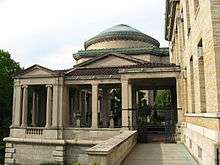
Nominees not elected
In addition to Constance Woolson and Jefferson Davis the following people were among those nominated at least once but not elected:
Samuel Adams, Louisa May Alcott, Johnny Appleseed, Chester A. Arthur, Sarah Franklin Bache, Henry Barnard, William Beaumont, John Shaw Billings, George Caleb Bingham, Elizabeth Blackwell, Elena Petrovna Blavatsky, Borden Parker Bowne, William Brewster, William Austin Burt, Horace Bushnell, John C. Calhoun, Alice Cary, Frederick Edwin Church, George Rogers Clark, George M. Cohan, Calvin Coolidge, John Singleton Copley, Dorothea Dix, Paul Dunbar, Amelia Earhart, Wyatt Earp, John Eliot, Henry Ford, James A. Garfield, William Lloyd Garrison, Lou Gehrig, Henry George, Horace Greeley, Sarah Josepha Buell Hale, Warren G. Harding, Benjamin Harrison, William Henry Harrison, Charles Evans Hughes, Richard M. Hoe, John Ireland, Helen Hunt Jackson, William James, John Jay, Andrew Johnson, Al Jolson, Chief Joseph, Adoniram Judson, Francis Scott Key, Joyce Kilmer, Fiorello La Guardia, Karl Landsteiner, Gilbert N. Lewis, Crawford Long, Huey Long, Cyrus McCormick, Robert McCormick, Ephraim McDowell, Charles Follen McKim, William McKinley, Ottmar Mergenthaler, S. Weir Mitchell, Lucretia Mott, Benjamin Peirce, Wendell Phillips, Hiram Powers, Will Rogers, Babe Ruth, Sacagawea, Jacob Schiff, Elizabeth Seton, Lydia Huntley Sigourney, Matthew Simpson, John Stevens, Robert L. Stevens, Nikola Tesla, Roger B. Taney, Benjamin Thompson, Judah Touro, Paul M. Warburg, Martha Washington, Mary Ball Washington, Francis Wayland, Noah Webster, William Henry Welch, Henry Wheaton, and Theodore Dwight Woolsey.[17]
Removals
Busts of Robert E. Lee and Stonewall Jackson were ordered removed from the Hall of Fame for Great Americans in August 2017 by New York Governor Andrew Cuomo.[16]
See also
References
Notes
- "National Register Information System". National Register of Historic Places. National Park Service. March 13, 2009.
- University Heights was New York University's main campus from 1894 to 1973.
- "Bronx Community College". Archived from the original on June 7, 2014. Retrieved November 22, 2012.
- According to Rubin (1997, p.14), her gift was $US2,000.000
- Cricco, Nancy; Bunde, Janet. "Closing a Campus | The College on a Hill". A history of New York University's Bronx Campus through its architecture. New York University Archives. Retrieved April 6, 2014.
- Ackman, Dan (October 12, 2007). "Fames's Fortune". The Wall Street Journal.
- Dolnickdec, Sam (December 5, 2009). "A Hall of Fame, Forgotten and Forlorn". The New York Times. p. A17. Retrieved August 5, 2019.
Welcome to the Hall of Fame for Great Americans, a lonely outpost in the University Heights section of the Bronx. When it was founded in 1900, it was the first Hall of Fame in the nation, local historians say, and the elections to induct members were covered by the national press.
- Rubin (1997), p.14.
- MacCracken, Henry Mitchell (1900), "The Hall of Fame," The American Monthly Review of Reviews, vol XXII (July–December 1900), p. 563
- "Hall of Fame and Statue of Bavaria". Bayerische Schlösserverwaltung. 2007. Retrieved January 2, 2008.
- de:Ruhmeshalle (München)
- "Cultural Resource Information System (CRIS)". New York State Office of Parks, Recreation and Historic Preservation. Archived from the original (Searchable database) on July 1, 2015. Retrieved March 1, 2016. Note: This includes Joan R. Olshansky and Elizabeth Spencer-Ralph (n.d.). "National Register of Historic Places Registration Form: Hall of Fame Complex" (PDF). Retrieved March 1, 2016. and Accompanying nine photographs
- Matt Sedensky, "The Original Hall of Fame Tries to Get Back on Its Feet", New York Times, November 25, 2001.
- Rubin (1997), pp.14–15.
- Rubin (1997), p.15.
- Jaeger, Max. "Cuomo orders Confederate busts removed from CUNY Hall of Fame". NY Post. Retrieved August 27, 2017.
- See excerpts from The People's Almanac series by David Wallechinsky and Irving Wallace found at pages linked from http://www.trivia-library.com/hall-of-fame-for-great-americans/index.htm .
Works cited
- Rubin, Richard (July 1997). "The Mall of Fame". The Atlantic Monthly. Vol. 280 no. 1. pp. 14–18. Retrieved August 5, 2019.
- Wallechinsky, David; Wallace, Irving (1978). "The Hall of Fame for Great Americans". The People's Almanac #2. New York: Bantam. pp. 1050–1056. ISBN 9780553011371. OCLC 872351514.
Other sources
- Bowery Boys (March 19, 2008). "New York City's Curious, Modern-Day Olympus". The Bowery Boys: New York City History (blog). Retrieved August 5, 2019.
- Johnson, Robert Underwood (1935). Your Hall of Fame: Being an Account of the Origin, Establishment, and History of This Division of New York University, from 1900 to 1935 Inclusive. New York: New York University. OCLC 269781.
External links
| Wikimedia Commons has media related to Hall of Fame for Great Americans. |

